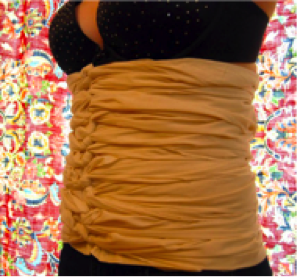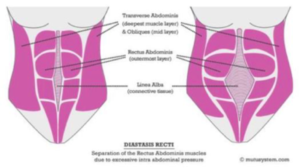Q: Anyone here try belly binding? I’m one week postpartum after my second cesarean and am wondering if this would be a good thing? Any insight would be great!
Signed,
Tied Up
A: What is Bengkung? Bengkung is a traditional Malaysian belly binding method. Essentially it is a practice of tying a long strip of cloth around the abdomen during the postpartum recovery period to ensure a strong support to the mother’s womb after childbirth. It is recommended that the bind be worn for up to 12 hours and then taken off for 12 hours. This is “training” the woman’s body to do on its own the same thing the bind helps to achieve. Before binding, be sure to spend about 10 minutes helping the woman to get her organs back up in her body so things are not bound in lower position. To do this, bind right after she gets up in the morning since she has been laying down for a while. Otherwise, put her feet up on the couch or do legs up the wall 10 minutes to help reposition those organs that have fallen a little lower because of pregnancy and childbirth and gravity. Be sure to have her keep her legs together when binding the hips to get the most benefit. Also, have the new mom take her underwear down and then pull up once a few binds over the hips are done. (She will need to be able to use the bathroom during the 12 hours of binding).
Why belly binding?
- It provides constant, steady pressure to the pelvic area and hips, which helps them to close as much as possible back to their previous width.
- Pulls the separated abdominal muscles back together. (diastasis recti see below)
- Relieves back pain by supporting the abdominals during the postpartum healing process
- Supports correct posture and spinal realignment and is good antidote to the “nursing-slouch.”
- Decreases postpartum bleeding time by speeding up the process of getting rid of waste blood in a natural way.
- Constant pressure encourages the organs in the torso and pelvis to shrink back and return to their pre-pregnancy size.
- Emotional/Spiritual benefits – Women enjoy the process of taking care of their bodies and being able to focus on their recovery and the healing process. They are able to really take that time out each day for self-care and get in touch with their new self and their new role as a mother. Many women use binding as a spiritual or symbolic closure of their pregnancy; especially if they didn’t receive the birth they envisioned.
More about Belly Binding
 During pregnancy a mother’s body retains water, fat, and air which cause her body to swell and expand, including the organs in the womb area such as the cervix and vagina. The water retained by cells supported the amniotic fluid and the purpose of the air was to cushion the baby, mother’s internal organs, and bones as her center of gravity shifted and her baby grew bigger and bigger. This is why a mother gets more and more swollen during the last months of pregnancy. When a baby is born, the excess water, fat, and flatulence are no longer needed and the cells will naturally release and shrink back to their pre-pregnant size. However, the purpose of a post-pregnancy wrap is to speed up this process with constant pressure on the abdomen and torso area.
During pregnancy a mother’s body retains water, fat, and air which cause her body to swell and expand, including the organs in the womb area such as the cervix and vagina. The water retained by cells supported the amniotic fluid and the purpose of the air was to cushion the baby, mother’s internal organs, and bones as her center of gravity shifted and her baby grew bigger and bigger. This is why a mother gets more and more swollen during the last months of pregnancy. When a baby is born, the excess water, fat, and flatulence are no longer needed and the cells will naturally release and shrink back to their pre-pregnant size. However, the purpose of a post-pregnancy wrap is to speed up this process with constant pressure on the abdomen and torso area.
A long post-pregnancy wrap provides a holistic support to all the abdominal and pelvic organs, including the muscles in the pelvic area. Support to the pelvic area is very important in the immediate weeks after birth as a mama’s cervix dilates 10 cm when active labor is reached, this is the equivalent to the size of an average bagel. Therefore the pressure of a longer wrap on the hip area helps the cervix shrink and allows the pelvic muscles to heal without being further stretched. Steady, pressured support on the hips allows the body to “close” more easily than if just left in its expanded state. The Bengkung style of binding is known to help heal diastasis recti with the constant supportive pressure on the abdomen area.
Repairing the diastasis recti
According to the Mayo Clinic, during pregnancy, the growing uterus stretches the muscles in the abdomen. This can cause the two large parallel bands of muscles that meet in the middle of the abdomen to separate — a condition called diastasis recti or diastasis recti abdominis. The Malaysian technique of Bengkung binding is helpful in bringing those bands of muscles back together in order for the  Linea Alba, or connective tissue, to strengthen and support the muscles more effectively.
Linea Alba, or connective tissue, to strengthen and support the muscles more effectively.
Graphic used with permission from mutuststem.com
Lower back support – The Bengkung method of binding is also helpful in supporting the lower back. It is well known that the abdominal muscles have a direct relationship to the back muscles. According to www.spine-health.com “the abdominal muscles and back muscles are key components of [a] muscular network, and provide the strength to keep the body upright and for movement. When these core muscles are in poor condition, additional stress is applied to the spine as it supports the body, and back injury or back pain is more likely.” With the abdominal support, the back is supported as well. Having lower back support helps to reduce strain and improves posture.
When should I get wrapped? It is recommended that for a vaginal delivery, you be wrapped within the first week postpartum and if you have had a cesarean 4-6 weeks postpartum with a doctor’s approval. You will continue to wrap for each day, for about 12 hours, up to around the 40 day mark.
Who should not wear a postpartum wrap? Any women who is showing signs of infection, especially in a c-section wound, or has other pregnancy or delivery complications like preeclampsia or anmionitis should steer clear of belly binding, Dr. Ross says. This is why it’s so important to get the all-clear from your doc before putting one on.
Why shouldn’t I simply buy a belly band from the store? The Bengkung method of belly binding is incredibly adaptable to your specific body type, size, and shape. It uses muslin, and as your postpartum body changes and shrinks down you can simply rewrap yourself to accommodate your transforming body. Those standard belly bands also do not support your hips and ribs and can bulky and uncomfortable.

